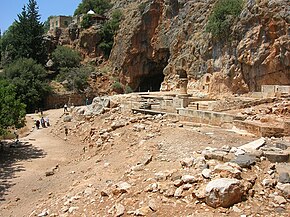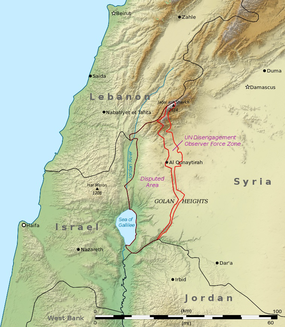Caesarea Philippi

Caesarea Philippi: remnants of the temple of Pan with Pan's grotto. The white-domed shrine of Nabi Khadr shows in the background.
|
|
| Alternate name | Neronias |
|---|---|
| Location | Golan Heights |
| Coordinates | 33°14′46″N 35°41′36″E / 33.246111°N 35.693333°E |
| Type | settlement |
| History | |
| Cultures | Hellenistic, Roman |
Caesarea Philippi - Ancient Greek: Καισαρεία Φιλίππεια or Caesarea Paneas (Καισαρεία Πανειάς); called "Neronias" for a short period of time - was an ancient Roman city located at the southwestern base of Mount Hermon. It was adjacent to a spring, grotto and related shrines dedicated to the Greek god Pan, and called "Paneas" since the Hellenistic period, a name which mutated in time to Banias, as we know it until today (not to be confused with Baniyas in northwestern Syria). The surrounding region was known as the "Panion".
The city is mentioned in the Gospels of Matthew and Mark. The city is now nearly uninhabited: it is an archaeological site in the Golan Heights called Banias.
Banias does not appear in the Old Testament. Philostorgius, Theodoret, Benjamin of Tudela, and Samuel ben Samson all incorrectly identified it with Laish (Tel Dan) while Eusebius of Caesarea accurately places Dan/Laish in the vicinity of Paneas at the fourth mile on the route to Tyre.
Alexander the Great's conquests started a process of Hellenisation in Egypt and Syria that continued for 1,000 years. Paneas was first settled in the Hellenistic period. The Ptolemaic kings, in the 3rd century BC, built a cult centre.
Panias is a spring, today known as Banias, named for Pan, the Greek god of desolate places. It lies close to the "way of the sea" mentioned by Isaiah, along which many armies of Antiquity marched. In the distant past a giant spring gushed from a cave in the limestone bedrock, tumbling down the valley to flow into the Huela marshes. Currently it is the source of the stream Nahal Senir. The Jordan River previously rose from the malaria-infested Huela marshes, but it now rises from this spring and two others at the base of Mount Hermon. The flow of the spring has decreased greatly in modern times. The water no longer gushes from the cave, but only seeps from the bedrock below it.
...
Wikipedia

